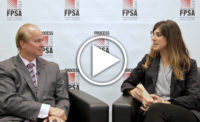Food Waste
ReFED Tackles Food Waste for the Industry and Companies
FOOD ENGINEERING discusses food waste with ReFED expert Jackie Suggitt, and how its data platform delivers business solutions for companies.

Image courtesy of Getty Images / Aleksandr Bushkov
Kraft heinz spent eight years and $1.2 million designing and engineering a fully recyclable closure with Berry Global for its ketchup packaging. Why? Consumer preferences want more recycled packaging and less waste. Besides package recycling, brands are also focused on reducing food waste, water conservation and other ways to optimize operations with technology.
Food waste is a relatively new challenge for food manufacturers, but solutions lead back to common themes in manufacturing: continuous improvement and removing inefficiencies. The bottom line is that food waste is an inefficiency but a complex one interconnected with many components within the food industry ecosystem—more on that later.
Recently, FOOD ENGINEERING magazine sat down with Jackie Suggitt, director of capital, innovation and engagement at ReFED. ReFED is a U.S.-based nonprofit working with food companies to reduce food waste. The interview touches on the interconnected nature of food waste—upstream and downstream—the organization’s Insights Engine data platform, a case study, its new Business Services program and more.
ReFED’s Insights Engine platform launched in February 2021 but is receiving more attention as consumers and brands elevate food waste. Through initiatives like the U.S. government’s Food Loss and Waste Champions 2030 and World Resources Institute’s 10x20x30, more than 200 food suppliers, manufacturers and retailers in 2020 committed to cutting their food waste in half by 2030.
Moreover, the EPA released a groundbreaking report in October 2023 that shows food waste is the leading material in landfills, causing methane emissions at 58%. Methane emissions are devastating but, for years, have not been measured consistently by a governing body or companies. However, Google and the Environmental Defense Fund, and many other third-party technology platforms are releasing methane-tracking tools (see sidebar).

Food waste and post-consumer recycled (PCR) content are significant issues and will take time. For example, packaging waste reduction goals for 2025 are almost here, but progress has been slow. As of early 2024, brands are not buying as much PCR content as expected, according to industry analyst Emily Friedman, plastics expert and senior editor at ICIS, a chemical and energy intelligence provider. According to Friedman in a trade industry news report, February and March are “preform season.” During this season, demand increases while supply is at its highest during an average year.
“That’s a known, traditional pattern in the rPET space,” Friedman says. “But this year is interesting. We’re coming off very weak demand in 2023—many analysts venture that rPET demand was down as much as 15% in 2023—and we saw depressed prices throughout the whole year, not just at that late summer period.”
With PCR efforts stalling, this may be a prime time for brands to examine systemic food waste and reduce methane emissions. ReFED data analysis and business services may be the tools retailers and food and contract manufacturers can rely on for greater visibility. (The interview has been slightly edited for clarity and length.)
FOOD ENGINEERING: Can you provide an overview of ReFED’s Insights Engine data platform and how it tackles food waste within the food industry?
Jackie Suggitt: At its core, the Insights Engine (data platform) is a one-stop shop for data and insights on food loss and waste. ReFED takes in over 50 different data sets to help paint the picture of where food waste is happening, how much, why, where it is going and what are the causes of that waste. And then on the flip side of that coin, we model solutions and have over 40 different solutions.
The Insights Engine uses data from businesses, solution providers, case studies and academic research to model the cost to implement those solutions, but then also the financial, environmental and social impacts of those solutions.
So if I were a food business, I'd come to the Insights Engine to first understand why I should care? What is the problem? Where is it happening within my sector specifically and why? And then based on that, what are the solutions available to my company? Who are the partners available? And what are the impacts of those solutions if I were to implement them within my business?
FE: Lately, there’s been a lot of talk about stakeholder cooperation in solving systemic challenges related to sustainability. How does ReFED’s data and services help here?
Suggitt: The Insights Engine demonstrates that food waste is systemic. And, I don't mean that just in the sense that it happens throughout the entire system, but it happens because of decisions, policies and behaviors across the system.
So, something that goes to waste in manufacturing may not be because of a policy, behaviors or decisions made by the manufacturer. It can be a decision made by the grower or by the retailer, which could be made due to decisions by consumers. So, there's a lot of interconnectivity between where the driver of food waste is and where the actual food waste happens. That's why interconnectivity between sectors is so important on a topic like food waste because there are misaligned incentives of the burden of cost, and there are also misaligned incentives of the burden of value that comes back.
ReFED encompasses the entire supply chain with our data tools that are currently available. The Insights Engine maps across all business sectors: from growers to manufacturers to retail, food service, restaurant, etc.
FE: Besides the data modeling, what else is ReFED offering retail, restaurants, food manufacturers and contract manufacturers?
Suggitt: Beyond the Insights Engine, we have an additional suite of data tools that we use for more granular data reporting directly into ReFED and data reports that we give back to food businesses. Those are fully operational and available within the retail sector now, and this reporting is emerging out of pilot and into availability in manufacturing and food service this year.
Specifically, we call this tool a sector-based calculator, which is how we intake the data into our data model systems and we have custom solution roadmaps. The roadmaps provide industry benchmarking, solution metrics and prioritization by taking our Insights Engine model and running individual business data through it instead of a national data set. The thinking is, how can we reprioritize the solutions that are available based on that business's specific issues and data?

FE: So, let’s dive deeper into these business services.
Suggitt: There are three buckets of services that we provide one-on-one to businesses, and there are some collaborative projects I could talk about, too. But for one-on-one engagements, we have data products. So that's where we've developed tools for businesses to report data into ReFED. We use that to add to our Insights Engine and use it for these collaborative platforms to do progress reporting and benchmarking.
The way we've set up the methodology and the tool allows us to also provide data value back. Data is currency in many senses of the word. It is a huge effort for businesses to report data. We recognize that and acknowledge and want to provide value back in return.
If a business gives us their data, we can benchmark them against any other peers we have had in our Insights Engine database and the sector as a whole. Then, ReFED can take our 42 solutions and say, “Let's order these for you based on what we know as the causes of your waste, where that waste is going, where you operate and what departments that waste is in.” So here are the top five solutions in Insights Engine, and this is the cost per ton to estimate. We don't have all their financial data but cost per ton to implement.
What is the ROI? What are the environmental impacts of that to help kickstart the real internal economic and financial conversations about what it takes to implement solutions. So, we're all about decision-ready data. I think data for public reporting serves a purpose, but it’s not actually reducing food waste. So we try and translate that into something that can be taken internally to build the business case and justify investment in the solution.

FE: Providing these turnkey data solutions is important to customers, especially when examining the systemic and interconnected issues for retailers and manufacturers. Let’s get specific about products, such as produce. What are the dynamics in reducing food waste with produce?
Suggitt: For produce, it's interesting and depends on how you cut the data. So if you look by volume, produce is a key driver of waste by volume. If you look at greenhouse gas (GHG) emissions, meat and dairy will rise to the top, right? If you look at value, retail value, meat and dairy will stay up there. Prepared foods is going to jump up there, but produce is going to be very low.
So, this is where we have to start talking with businesses about where there is a priority. Is it actual tonnage reduction? Is it the climate impact? Is it a financial benefit? This can alter what the hotspots are within a business depending on whether it's volume-based or financial-based.
FE: Getting back to the partnerships and interconnectivity within the supply chain, can you give us an example?
Suggitt: The Pacific Coast Food Waste Commitment is a collaborative partnership of food businesses on the West Coast, and we identified produce as a priority area for that group last year. So we ran the first phase of a pilot in 2023 and mapped the supply chain of strawberries and frozen potatoes and said, let's zoom in.
We know a certain percentage of strawberries go to waste, but let's find out where in the supply chain and why. We mapped those supply chains and retailers, and we know that strawberry waste is primarily happening on the farm. It's primarily happening because produce specifications are too tight, labor is too short and we can't match strawberries to where they need to go.
So, we're now looking at some collaborative solutions those producers and retailers can do to bulk harvest all the strawberries, sort them offsite and send them to multiple specifications. At the end of the day, could we test new SKUs of smaller snacking strawberries? So, we've identified the data hotspots and are now looking at how we can implement solutions. And now we’ve taken the learnings from the Pacific Coast Food Waste Commitment and nationally launched the U.S. Food Waste Pact, which is helping businesses across the country to reduce waste.
Looking for a reprint of this article?
From high-res PDFs to custom plaques, order your copy today!








